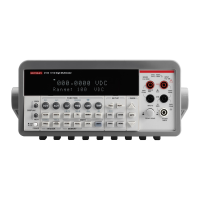B-4 Return to Section Topics 2100-900-01 Rev. D / September 2011
Appendix B: Remote Interface Reference Model 2100 6 1/2-Digit Resolution Digital Multimeter User’s Manual
NOTE If you send two query commands without reading the response from the first, and then
attempt to read the second response, you may receive some data from the first
response followed by the complete second response. To avoid this, do not send a
query command without reading the response. When you cannot avoid this situation,
send a device clear before sending the second query command.
SCPI command terminators
A command string sent to the multimeter must terminate with a <new line> character. The
IEEE-488 EOI (end-or-identify) message is interpreted as a <new line> character and can be used
to terminate a command string in place of a <new line> character. A <carriage return> followed by
a <new line> is also accepted. Command string termination will always reset the current SCPI
command path to the root level.
IEEE-488.2 common commands
The IEEE-488.2 standard defines a set of common commands that perform functions like reset,
self-test, and status operations. Common commands always begin with an asterisk ( * ), are four to
five characters in length, and may include one or more parameters. The command keyword is
separated from the first parameter by a blank space.
Use a semicolon ( ; ) to separate multiple commands as shown below:
"*RST; *CLS; *ESE 32; *OPC?"
SCPI parameter types
The SCPI language defines several different data formats to be used in program messages and
response messages:
Numeric parameters
Commands that require numeric parameters will accept all commonly used decimal
representations of numbers including optional signs, decimal points, and scientific notation.
Special values for numeric parameters like MINimum, MAXimum, and DEFault are also
accepted. You can also send engineering unit suffixes with numeric parameters (e.g., M, K, or u). If
only specific numeric values are accepted, the multimeter will automatically round the input
numeric parameters. The following command uses a numeric parameter:
VOLTage:DC:RANGe {<range>|MINimum|MAXimum}

